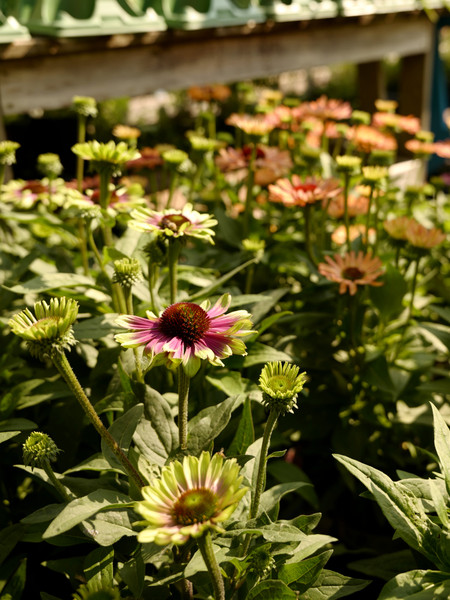Fall & Winter Garden Prep
Posted by Jessie Jacobson on Sep 22nd 2025
Fall & Winter Garden Prep
As the sun sets earlier and earlier in the sky each week and casts a distinctly autumnal light on the cooler days ahead, it's time to start thinking about next season. Taking the time to prepare your garden for winter will give you a head start on next year, ensuring your plants are healthy and protected so they come back beautiful and healthy next year.
Cut them back
While many gardeners prefer to cut back their gardens entirely to leave a clean slate for the spring, doing so is not always the best decision for the health of your plants or for the many local pollinators that call your garden home. Many plants offer winter interest in the landscape with ornamental berries, exfoliating bark, or dried blooms- and also serve as a habitat & food source for local songbirds and other wildlife.
For many plants, leaving the tops intact will aid in winter protection and survival. This helps to protect their crowns, as well as to hold protective mulch layers and snow that serve as additional insulation during particularly cold winters. This is especially important in windswept areas or those with little snow cover.
However, there are some plants that reap little benefit if their tops are left intact. These plants that do not benefit as much should be cut back to about three inches high after the first frost, to avoid messy cleanup in the spring. Any diseased plants should also be cut back and disposed of, not added to your compost pile.
Plants that should be cut back in the fall include:
- Alcea (Hollyhock)
- Aquilegia (Columbine)
- Coreopsis (Tickseed)
- Delphinium
- Dicentra (Bleeding Heart)
- Geranium (Cranesbill)
- Heliopsis (False Sunflower)
- Hemerocallis (Daylilies)
- Hosta
- Iris
- Monarda (Bee Balm)
- Peonies
Plants that should not be cut back in the fall include:
- Achillea (Yarrow)
- Aster
- Bergenia (Pigsqueak)
- Chrysanthemums (Mums)
- Echinacea (Coneflower)—great for birds
- Gaillardia (Blanket Flower)
- Geum (Avens)
- Grasses
- Heuchera (Coral Bells)
- Syringa (Lilac)
- Panicle Hydrangea
- Penstemon (Beardtongue)
- Salvia (Sage)
- Tiarella (Foamflower)
- Weigela
Water, water, water
Even as the days and nights get cooler, your plants are still using water as they continue to grow their roots and prepare for the long winter ahead. Fall air can be particularly drying, especially following those hot, late-summer days. Perennial plants, trees, and shrubs will appreciate a good drink before the arid winter months. Be sure to keep your plants watered (about one inch of water per week) up until the first hard frost, to make sure your plants are healthy and ready for winter.
Tuck them in
Once we have a few hard frosts and the ground is good & frozen for the year, it's time to tuck the garden in.
Top dress garden beds with a layer of Purple Cow Activated Compost to get a head start on next season. When the ground begins to thaw in the spring, the compost will settle into the soil with the help of spring rains. This provides a gentle nutritional supplement that also helps give your soil composition a boost.
Following the application of compost, it is important to apply a thick layer of mulch to keep plants protected from frigid temperatures, damaging freeze-thaw cycles, and even early January thaws. Mulch your perennials with a substantial layer, at least six inches thick, of fallen leaves, rye straw, or marsh hay to provide insulation and keep ground temperatures consistent throughout the winter. Be sure to wait to mulch until the ground is frozen solid to prevent any mold or disease issues. This also helps to avoid tricking your plants into thinking it is a balmy spring day, which may rouse them prematurely from their winter slumber. Remove the mulch in the spring when new growth begins to emerge. Be sure to keep some mulch on standby until our last frost date, in the event that we have a late freeze and your plants need last minute protection.
Don’t forget about trees and shrubs! Be sure to keep watering trees and shrubs - especially any newly planted this fall. Trees and shrubs with young, tender bark are also prime feeding for deer and other critters. Protect young plants with a wrap of burlap or hard plastic to prevent feeding & avoid girdling which can lead to other issues down the road. Leave any tree pruning until the spring.
Divide and Conquer
Fall is a great time to reflect on garden design and performance. Consider dividing perennials to keep borders tidy, plant structure tight, and blooms prolific. Cut, saw, or pull apart root balls, leaving at least two to three new shoots per segment. Plant at the same depth as the original plant that was divided, and be sure to water in thoroughly until frost. Great candidates for fall division include Astilbe, Lilies, Irises (both Siberian and Japanese Iris), Peonies, Hosta, and Veronica. Check out this video about dividing and transplanting perennials! And another one too!
Enjoy your gardens!
Always be sure to take time to enjoy the cool fall air and fall color before frigid temperatures and snow return! You can also take this time to think about what’s next in the garden. Here are a few of our favorite perennial gardening videos to keep you busy and inspired!
Planting Perennials in the Fall
Always growing
Don't forget to check out our Perennial Library on our website. Here we house tons of information and inspiration including care cards, garden plans, blog posts, and videos!

